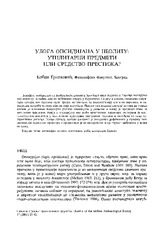Приказ основних података о документу
Uloga opsidijana u neolitu - utilitarni predmeti ili sredstvo prestiža?
Role of obsidian in the Neolithic: Utilitarian objects or means of prestige
| dc.creator | Tripković, Boban | |
| dc.date.accessioned | 2021-10-12T10:24:32Z | |
| dc.date.available | 2021-10-12T10:24:32Z | |
| dc.date.issued | 2001 | |
| dc.identifier.issn | 0352-5678 | |
| dc.identifier.uri | http://reff.f.bg.ac.rs/handle/123456789/353 | |
| dc.description.abstract | Ležišta opsidijana na centralnobalkanskom prostoru nisu poznata i lokalne neolitske zajednice su ga nabavljale iz najbližih izvora u Karpatima. Sa druge strane, geološka struktura centralnog Balkana nudi brojne mogućnosti za eksploataciju sličnih sirovina i neposredna potreba za opsidijanom nije postojala. Prilog predstavlja pokušaj autora da utvrdi kakvim je motivima pokrenuto učešće opsidijana u razmeni i kakvu je vrednost imao za neolitske zajednice. Ideja o opsidijanu kao robi prestižnog karaktera testirana je kontekstualnom analizom u neolitskim kulturama centralnog Balkana i ponuđena su neka alternativna rešenja. Prema autoru, njegova vrednost je generalno definisana u procesu neolitizacije evropskog prostora i proistekla je iz istorijskog i kulturnog ambijenta u kojem se javlja. | sr |
| dc.description.abstract | We presented in this work how the value of obsidian could be examined from different standpoints even within such general category as is the principle of general relation to the Neolithic cultures and that acquired results do not essentially stand out and do not negate each other. The idea of obsidian as the means of prestige had been tested by contextual analysis in the Neolithic cultures of the central Balkans. The acquired result did not confirm the assumption that obsidian was used as the means to denote the status and distinction of the individuals among the other members of the community. However, it has been indicated that wish for obsidian, need to acquire it, participation in the exchange system and large distance from which it was obtained could be the indication of the certain system of values and beliefs that was generally appreciated within the Neolithic communities. Therefore, we examined the alternative hypothesis by analyzing the value of obsidian in the ideological contexts which could be most easily designated by the expressions as 'ancestral stone', 'stone from the past', 'mythical stone' etc. Understood in such a way obsidian represented a metaphor of the new, Neolithic way of life and its realization in all segments, the model for that being the populations from the East by means of which they got acquainted with it. The essential difference is, however, in the comprehension of the historic role of the obsidian. It represented, in Anadolia and the Near East, mechanism or one of the mechanisms of the process of Neolitization while in Europe, in certain regions such function has also been indicated. Value of obsidian could and should be verified in different ways and in other cultures. It is probable that new data and different initial viewpoints could influence making of certain new assumptions. So, I think that we should not insist definitely on any of the solutions especially if there is great potentiality for further investigations. But in the course of the future investigations the following scenarios should be taken as premises: Obsidian had not been prestigious good. Its frequent occurrence at the sites near the sources is the consequence of the relatively easy access and intensive exploitation. In the regions out of the zones of origin it does not occur so often and it is the confirmation for trade in the Neolithic. Obsidian had been prestigious good. Its rather rare occurrence, good mechanical characteristics, highly esteemed aesthetic values and difficult conditions of procurement are just some of the reasons why obsidian had been treated as means of prestige within Neolithic communities. Along with other kind of similar goods obsidian had been main object of exchange but at the same time it stimulated the exchange of goods necessary in everyday life. There is the question whether it should have been apparent also by large deposits (grave, hoard, etc) within archaeological context. Experience that we have so far does not speak in favor of such an assumption. There has been the need for every Neolithic culture at least within its larger centers to possess certain amount of obsidian but not as prestigious value and not as the object used to confirm individual identities. The need for obsidian appeared as the result of the information about the ways of introduction of the new forms of existence 'somewhere in the east' and an attempt to create identical history. In that sense the obsidian besides its utilitarian function might has had distinct and explicit symbolic concept. It used as metaphor, as medium by which history had been imitated and complemented should denote Ncolitization on the psychological level. Therefore there was no need for its contextualization, as by narrative transmission the value of obsidian had not been connected to concrete, particular things or events but to the general principles. Its main purpose for the community had been achieved already by the very act of procurement and its further biography had been attained through the activities of physical utilization. | en |
| dc.publisher | Srpsko arheološko društvo, Beograd | |
| dc.rights | openAccess | |
| dc.source | Glasnik Srpskog arheološkog društva | |
| dc.subject | prestižna roba | sr |
| dc.subject | opsidijan | sr |
| dc.subject | neolit | sr |
| dc.subject | centralni Balkan | sr |
| dc.title | Uloga opsidijana u neolitu - utilitarni predmeti ili sredstvo prestiža? | sr |
| dc.title | Role of obsidian in the Neolithic: Utilitarian objects or means of prestige | en |
| dc.type | article | |
| dc.rights.license | ARR | |
| dc.citation.epage | 42 | |
| dc.citation.issue | 17 | |
| dc.citation.other | (17): 21-42 | |
| dc.citation.spage | 21 | |
| dc.identifier.fulltext | http://reff.f.bg.ac.rs/bitstream/id/1928/350.pdf | |
| dc.identifier.rcub | https://hdl.handle.net/21.15107/rcub_reff_353 | |
| dc.type.version | publishedVersion |

